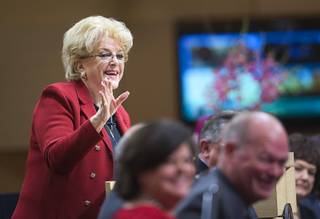Related news
It’s late 2011, and you’ve just moved to Las Vegas.
You decide to explore Fremont Street, and you wander into El Cortez. When it’s time to go to the next stop, you exit onto Fremont. You look left, toward the east.
And the scene is one of those things you can’t unsee.
It’s dark down there, mostly a collection of run-down hotels interspersed with vacant buildings and lots with trash blowing around them. The Container Park, the fire-spewing mantis, the hip restaurants in renovated buildings — none of it exists. The Western Hotel is open, but there’s not much of a crowd and the place will close in early 2012. Atomic Liquors is more than two years away from being renovated and becoming a trendy hangout. The decay is shocking.
Or at least it was for me. I was there, standing with my wife in front of El Cortez a few weeks after moving to Las Vegas in late summer of 2011.
I thought of that scene tonight as Mayor Carolyn Goodman, who took office that year, made her State of the City speech. When Goodman talks about the progress that Las Vegas has made in recent years, those of us who moved here during the teeth of the recession know it’s not just self-serving politician-speak.
Beyond the improvements downtown — which the city received through the luck of the draw when the Downtown Project started transforming it with $350 million in investments — the city has made infrastructure upgrades, attracted new businesses and jobs, and beefed up public safety during Goodman’s years in office.
But we recession-era transplants also know there’s a long way to go for Las Vegas to reach Goodman’s goal of becoming a world-class city, sort of like East Fremont had a long way to go in 2011 to reach the point where taking a walk after sundown there didn’t feel like playing Russian roulette.
True to the form she’s displayed in previous versions of the speech, Goodman focused more tonight on the accomplishments than the challenges.
Among the successes: Completion of a 10-year effort to power the city’s 140 buildings, its parks and its streetlights with 100 percent renewable energy; becoming the first city to test an autonomous shuttle bus; bringing in more than 60 new businesses, including the Lucky Dragon Casino -- the first ground-up casino project in Las Vegas since before the recession.
“We’ve had so many exciting things happen this year,” Goodman said.
Fair enough. The accomplishments deserved the applause they received.
But there’s grinding work to be done — the type that doesn’t fit well into a feel-good speech. To attain her bold prediction for this year — “I see nothing but growth and prosperity through the city” — here needs to be significant progress on a number of fronts. Among them:
Goodman listed public safety as one of her top five priorities for this year, but she didn’t specifically mention that the valley recorded a record number of murders in 2016. Las Vegas already struggles to entice major employers, due in no small part to Clark County’s underperforming schools, and an alarming rise in homicides only makes it more difficult.
Massive improvements are needed in public transportation. The equation for traffic capacity on the valley’s existing road system is ugly: A record of 42.9 million visitors last year plus an ongoing increase in the population plus a grid that was already taxed equal a nightmare. Las Vegas needs a way to move a lot of people efficiently. Think of any world-class city, and chances are good that it’s home to a light-rail system. The Regional Transportation Commission is working toward establishing a system connecting UNLV to downtown and on to North Las Vegas, but the bulk of the transportation problem won’t be solved until there’s a more extensive solution that will ease congestion on the Strip. And that requires …
Creating some semblance of detente between the city and Clark County. Goodman made an oblique reference to friction between local governments when she said the valley would eclipse 43 million visitors and 2.2 million residents in 2017 and would continue to thrive economically — “that is, if we work together as one.”
Cracking down on squatters and blight. The valley doesn’t have a squatter problem, it has a squatter epidemic. At least three times in the past month, there have been fires caused by squatters. Meanwhile, vacant homes abound, hurting property values and becoming magnets for vandalism and other crimes.
But it wasn’t a night to focus on negatives. Goodman sent the crowd away smiling, saying she planned to seek more federal funding for terrorism and security preparedness, believed additional funding for public education could be found by examining the central administration’s spending, would advocate for better mental health services and would continue working to bring a major-league sports team to a stadium in the city limits.
The city’s challenges today are different than the ones it was facing when Goodman gave her first State of the City address — when an outflow of population, a wave of foreclosures and a sharp decline in visitors left local governments with vastly depleted tax revenue.
But as anybody knows if they watched what’s happened since 2011, there’s reason for optimism that the problems can be solved.



Join the Discussion:
Check this out for a full explanation of our conversion to the LiveFyre commenting system and instructions on how to sign up for an account.
Full comments policy